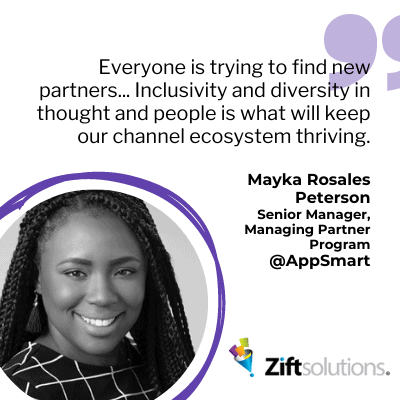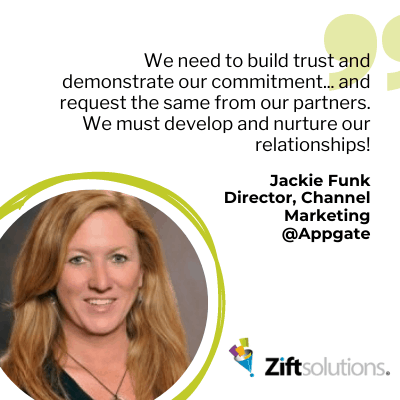-
Keeping partners engaged is vital to building a solid channel revenue engine and a primary goal for all firms involved in the channel.
-
Successful channel partner programs nurture relationships between the parties and foster “true partnership.” Therefore, healthy partner engagement is a sign of a healthy partnership.
-
One size does not fit all. New and long-term partners require different levels of – and approaches to – support.
-
Inactive or lost customers are best approached methodically and directly. If your companies’ goals remain aligned, give them a reason to re-engage.
-
Analytics can help you evaluate and retain current partners and re-engage lost or inactive partners you’d like to recover.
-
Like any meaningful relationship, open communications lines are essential to keeping channel partner relationships fruitful.
Channel programs are a sticky business. Or at least they are if you’re doing them right. It takes as much effort or more (often more) to recruit and retain a good channel partner as it does a good enterprise client. Just as developing customer stickiness is essential to revenue growth, creating partner stickiness is essential to growing your base of revenue-producing partners. That means doubling down on partner engagement. Like so many aspects of the channel, creating your partner engagement plan requires effort, but it can pay off by helping to fuel a formidable engine for growth.

What is Successful Channel Partner Engagement?
Ask seven channel experts what defines successful partner engagement, and you’ll likely get seven different – but highly valuable – answers. We did just that and then asked more questions to develop a list of channel engagement practices you can put to work.
We’ll dig into those responses in a moment, but first, let’s answer the question about what successful partner engagement means at Zift. We define successful channel partner engagement as successful collaboration with channel partners that helps both organizations achieve their goals. In other words, it means developing and maintaining an authentic, ongoing partnership.
Now, where were we? Oh, yes. Our seven experts, how they define successful engagement, and their advice for creating programs that work.
On defining success, they remind us of all the things that matter in a partnership, including:
“Partner engagement is … a joint strategy that leads to the success of both companies in the partnership.”
Vicki Patten, Global Partner Manager, Rackspace Technology
“Ideally, partner engagement is when a partner is actively engaged in the learning process.”
Eric Brooker, Vice President of Sales, Bigleaf Networks
“I define partner engagement in two ways: One, I view myself as a valued member of partners’ teams. If I’m not giving partners what they need and want to help them grow, then I’m not doing a good job. Two, I see partner engagement as what purpose I can bring to their lives to continue their growth.”
Tony Burns, Channel Account Manager, Mitel
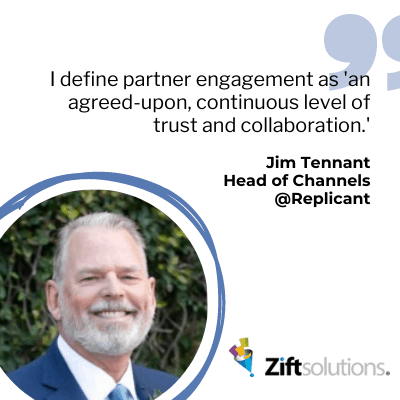
“I define partner engagement as ‘an agreed-upon, continuous level of trust and collaboration.’”
Jim Tennant, Head of Channels, Replicant
“Partner engagement means being top of mind and making sure they have everything they need to be successful.”
Mayka Rosales Peterson, Senior Manager, Managing Partner Program, AppSmart
“Anything that drives consistent interaction and communication falls into my definition of [partner] engagement.”
Jeff Mattan, Vice President, Global Partner Programs, BeyondTrust
“[Partner engagement means the] partnership is a two-way street.”
Steve Braverman, Founding Partner, EagleTEQ Advisors
“To me, partner engagement is all about building relationships, demonstrating commitment, and aligning goals across the partner organization (Leadership, Sales, Marketing, Professional Services, Product, Support, etc.)”
Jackie Funk, Director, Channel Marketing, Appgate
7 Partner Engagement Best Practices from Channel Leaders
We asked our channel engagement experts more than just how they define partner engagement. As BCG advises, partnerships need attention. So, we asked our panelists how to succeed in engaging the channel, and we came away with seven best practices you can put to work right away:
- Give New Partners Lots of Attention
- Refresh Long-Term Partner Relationships
- Re-engage Inactive Partners
- Give Inactive Partners a Reason to Re-Engage
- Sometimes It’s (More Than) OK to Move On
- Use Metrics to Measure Engagement
- Open Communication Is Essential to Long-Term Success
Best Practice 1: Give New Partners Lots of Attention
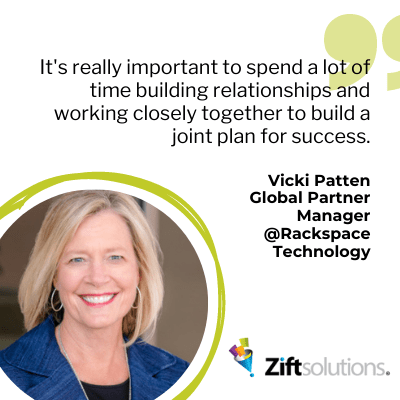
One of the running themes in our blogs is the importance of first impressions with channel partners and how vital onboarding is to gaining their trust and ongoing commitment. Our engagement experts reaffirmed this strategy with their advice for new partner engagement. Here’s what they recommend:
- Spend plenty of one-on-one time with new partners. Rackspace’s Patten says with new partners, “it’s really important to spend a lot of time building relationships and working closely together to build a joint plan for success.” The real challenge, she says, is “getting their focused attention and keeping it going after those initial planning meetings.” She addresses these needs by meeting in person as much as possible to stay “top of mind.”
- Get your onboarding down pat. “Engaging new partners is getting them onboarded and into the LMS,” says Bigleaf’s Brooker. Follow-on actions include “providing them portal access, measuring their portal usage, getting them through our certification process.”
- Lead with your products. “When engaging new partners, you have to show them what’s exciting about your product,” says Mitel’s Burns. “Show what makes your product special and how we can improve your customer’s business.”
- Embrace the new generation. “Everyone is trying to find new partners, especially from younger generations and backgrounds that might not understand what the channel is and can offer new perspectives on how to do business,” says AppSmart’s Rosales Peterson. “Inclusivity and diversity in thought and people is what will keep our channel ecosystem thriving.”
Best Practice 2: Refresh Long-Term Partner Relationships
“Longer-term partners give you more benefit of the doubt,” as BeyondTrust’s Mattan puts it, but it’s essential to keep the partnership refreshed and renewed. Our experts advise:
- Maintain those QBRs. Rackspace’s Patten says to avoid the pitfall of riding on past successes by “doing the QBRs and resetting goals each year to keep the revenue growing for both partners.”
- Keep partners updated on product releases and updates. “With long-term partners, it is about making sure they are aware of changes within your product set and company,” says Bigleaf’s Brooker.
- Protect your partners from poachers. “As partners get bigger, they pop up on the radar of the entire industry,” notes EagleTEQ’s Braverman. “You need to maintain relationships to incentivize partners and keep that stickiness, so they’re engaged.”
- Spice up the marriage. “For older partners, you’ve got to be working just as hard as you would with new partners,” says Mitel’s Burns. “Engaging older partners is like a marriage: if you don’t do date night, that marriage may fail. Keep that spark and interest alive with older partners. Be available to them, show you respect them.”
Best Practice 3: Re-engage Inactive Partners
As EagleTEQ’s Braverman points out, good partners land on everyone’s target lists—including your competitors. Poaching is one reason partners may go dark, but it’s not the only one. Your compensation, support or solution set also could be driving them away. Rather than guess, our experts said a direct approach is best.
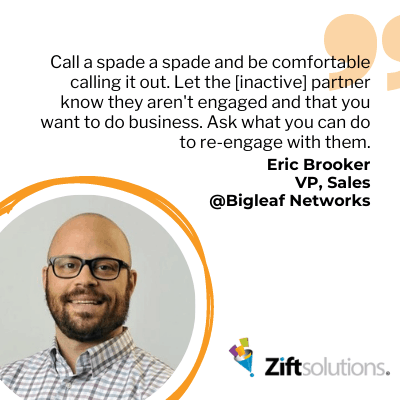
“Honestly, have a live, candid conversation about the commitment on both sides,” says Rackspace’s Patten. “If it’s not there or there is no longer a fit, move on!”
Bigleaf’s Brooker agrees. “Call a spade a spade and be comfortable calling it out,” he says. “Let the partner know they aren’t engaged and that you want to do business. Ask what you can do to re-engage with them. Ask why you aren’t winning business. Be willing to start from scratch and address the fact that you want them to re-engage and see if they are open to digging in and working together.”
Keep in mind that the cause of your “breakup” could have nothing to do with you. (It’s them, not you!) “Partners are constantly changing their goals, focus, and initiatives within their organization,” says Replicant’s Tennant. “Non-engaged partners could be non-engaging for a variety of reasons.”
Tennant’s three-point strategy for re-engagement is to:
- Establish an agreed-upon communication cadence
- Provide information to your partner that’s new and drives engagement
- Be respectful if the partner’s direction has changed and they need to focus elsewhere, but stay in touch as they just have other priorities to attend to
Best Practice 4: Give Inactive Partners a Reason to Re-Engage
After you’ve had that frank conversation with lost or inactive partners, it’s essential to give them a reason to come back.
“You need to make it easy for them to interact, and there must be a value prop for them,” says BeyondTrust’s Mattan. “Use data to try to predict what will resonate with them or to try to get them to read a case study about a customer in markets they serve, to try to get them to do one thing with you they aren’t doing now. And then [it’s a matter of] repeating that process on the next thing until they reach a level you determine as ‘re-engaged.” It takes data, patience and creativity.
Appgate’s Funk says that it’s vital to re-evaluate inactive partners to ensure they’re still a good match and that your goals remain aligned. If the answer is “yes” to both of those questions, her team seeks to re-engage them by:
- Bringing them leads
- Providing training and certification opportunities
- Sharing the successes her team has had with similar partners
- Lining up account mapping sessions
Best Practice 5: Sometimes It’s (More Than) OK to Move On
As Appgate’s Funk and Rackspace’s Patten point out, sometimes partnerships are just a bad fit. When that happens, it’s not only OK to move on but it’s wise to do so. Spend your time and resources on engaged and happy partners. And find more like them.
“If a partner isn’t engaged and we have tried a number of different ways to increase engagement, we need to take a closer look at the partnership,” says Bigleaf’s Brooker. “This may not be the type of partner we want to work with, and that needs to be OK.”
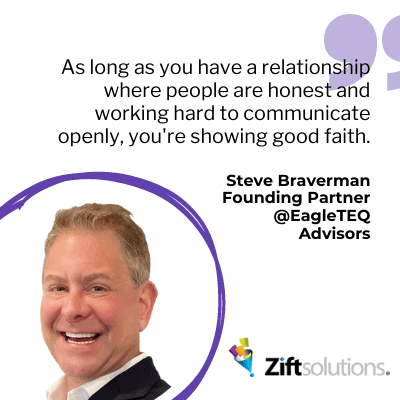
Funk’s team at Appgate sorts good-fit partners from bad-fit partners from the get-go by asking new partners to demonstrate commitment on their side of the partnership. “We ask that they put ‘skin in the game’ – achieving certifications, participating in training, and working closely with their assigned channel sales executive to build territory plans and perform account mapping,” Funk says. “We evaluate key metrics to determine where investments will be made going forward and to reward/recognize those partners who commit to those behaviors and actions that result in success.”
Best Practice 6: Use Metrics to Measure Engagement
We couldn’t help but notice that Mattan uses the d-word (data) in his advice for re-engagement. Analytics are always helpful, and establishing measurements for partner engagement metrics can go a long way toward keeping your program on the right track (and hopefully having fewer discussions with inactive partners).
As is often the case in analytics, our experts and their firms measure engagement in various ways. Those include:
- Pipeline and revenue, including leads generated and converted to prospects and prospects converted to customers
- Participation in QBRs and planning meetings
- Portal and content use, including logins, downloads, etc.
- Participation in training or certifications earned
Best Practice 7: Open Communication Is Essential to Long-Term Success
Not surprisingly, our diverse panel of experts offered varied insight, but one common theme threaded its way through every conversation— the need to have open communication.
“As long as you have a relationship where people are honest and working hard to communicate openly, you’re showing good faith,” says EagleTEQ’s Braverman. “Keep that policy for openness. Working with partners is really just one large partnership of support.”
BeyondTrust’s Mattan says talking is more than half the battle. “Regularly talk with your partners about what they need, how they want to communicate, where you are jointly missing opportunities, etc.,” he says. “They’ll give you 80 percent of what you need. It’s up to you to try other methods of engaging that fill in that other 20 percent, so this is where your data and creativity come in.”
Replicant’s Tennant advocates knowledge sharing. “Stayed informed yourself, and help your partners stay informed,” he says. “Stay informed at a macro and micro level.”
Open communication means taking information in, not just blasting it out. “We need to truly understand the partner’s business,” says Bigleaf’s Brooker. “We need to understand what is important to them and work up a mutually beneficial business plan. If we take the time to understand them and what would make us win together based on their definition, not ours, they will be more engaged.”
“We need to build trust and demonstrate our commitment… and request the same from our partners,” says Appgate’s Funk. “We must develop and nurture our relationships!”
Amen to that.
Aligning Activities to a Successful Partner Engagement Plan
Aligning your activities and goals with your partner engagement plan takes effort and organization, but it doesn’t have to be painful. An article we put together on key elements of a successful partner engagement plan provides a solid framework to help you get started. Those include:
- Build strong relationships between your organizations. You’ll never engage your partners if you treat channel activity as a task. Partner relationships need nurturing (see the points below—especially 4 and 5).
- Develop partner-friendly programs and content that can help them close business. As we always say, help a partner grow their business and you’ll keep that partner for life. Sales training, product education, white-label materials, and even closing support can keep your partners productive and coming back for more.
- Communicate consistently with your partners. Things change fast in today’s business world. In the tech space, it happens at a dizzying speed. Help keep partners current on technology changes, product releases, feature updates and even industry trends. That, in turn, helps your partners remain knowledgeable and helpful to their customers, which means more revenue for you and your partners.
- Get partner buy-in on your programs. The best way to make sure you’re meeting your partners’ needs is to ask them. Too often, companies create programs or materials that miss the mark with partner needs. It’s a partnership. Give them a seat at your design table.
- Get channel manager buy-in. Your channel managers also need a seat at the table. They’re in the trenches with your partners every day and help you develop or refine your program with real-world insight gleaned from work with many partners.
Laz Gonzalez
Laz Gonzalez is Chief Strategy Officer at Zift Solutions. A prominent industry analyst and thought leader, Gonzalez brings unparalleled channel expertise to Zift and has served as strategic adviser to leading B2B channel programs worldwide.

